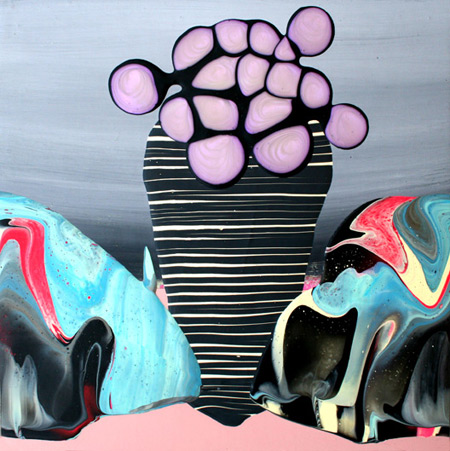
Continuing through December 15, 2012
With her current series of playful abstract paintings titled “Living in the Pink and Green,” Los Angeles artist Marion Lane has attempted “to provide a place where, if the time is right, an eyeball will stop, go back, and proceed again. It is this freewheeling rogue eyeball that is so elusive and yet so enjoyable, which gives rise to the pleasures of sight.” And it is the pursuit of these pleasures of sight, the artist contends, that “drives us into the future.”
We’re definitely living in the artist’s future when we gaze upon these paintings. They are purely abstract in their tumbling forms and colors, but without a doubt they reject the austerity, the humorless piety of so much abstraction that is to be found within the precincts of high modernism. This aptly titled show, which references the least serious color on the chromatic spectrum and its complementary opposite, invites and rewards the onlooker’s gaze with whimsy; our first impression is of a total absence of artistic pretense. Ocular joy, visual delight, seems to be the sole mandate of these acrylic paintings on panels, each one of which is a 13 by 13 inches square, a scale that reinforces the childlike playfulness of the series.
Acknowledging that the paintings are “heavily influenced by television,” the artist also characterizes them as “topological landscapes.” Those particular landscapes would have to be that of so-called popular culture, that variegated and patchwork beast that lives everywhere today through the virtual eye of our numerous digital devices. The vast electronic soup of visual culture in the 21st century has already absorbed all of the products of history, by it Japanese kitsch, French Rococo or 1970s Americana, three sources the artist singles out as having influenced the present work.
The paintings are all untitled, a decision on the part of the artist which may free our interpretation of the work but certainly renders the job of the art critic more problematic. I’ll single out a few paintings by describing their forms and colors. Many of them look like pulled taffy, three-dimensionally rendered, so that the shapes appear to have volume. There’s a real sculptural feeling in many of the works as circular masses are piled on one another. Op Art, itself a form of sheer visual play, is referenced as well in several of the works. The color palette makes little use of candy-bright primary hues, but languishes in subtle use of secondary values.
A repetitive visual strategy of the artist is to lay masses of color volume over a background of vertical lines and thrusts. This makes the volumetric nature of the foreground piles of color even more exaggerated. Other paintings depict what might be alien landscapes or urban worlds of biomorphic constructions. This is an unnecessary argument with their status as abstractions, given their chromatic and volumetric character. The images seem so familiar. And they fibrillate between recognitions that are familiar or strange but never ominous.
Philip Guston might have eventually made paintings like these had he continued to work with lyric abstraction while adopting cartoon biomorphisms less recognizable than the childlike cartoons he embraced after his Abstract Expressionist phase. Your mind will want to see things in these paintings, to forge resemblances or eidetic configurations, out of these graceful forms. Go ahead. You can do that. But always, despite their loopy humor, Lane’s work reminds us of nothing so much as the sheer visual pleasure of applying paint and line, chromatic volumes and masses, to a surface that will hold them.
Published courtesy of ArtSceneCal ©2012
